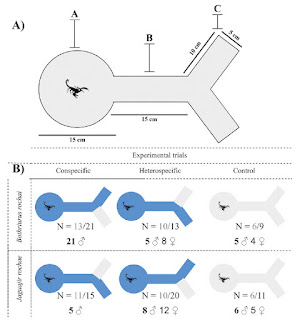It is well known that scorpions can detect and use chemical cues thanks to chemosensitive hairs on the pectins and on part of the pedipalps. Chemical cues can be used to discover and seek out conspecifics for mating, but also to avoid conspecifics or other scorpions that want to eat you (cannibalism is well documented in scorpions, often larger individuals preying on smaller and larger females may also kill and eat potential suitors).
Welton Dionisio-da-Silva and co-workers published earlier this summer a study of the use of chemical cues in the two Brazilian scorpions Bothriurus rochai Mello-Leitão, 1932 (Bothriuridae) and Jaguajir rochae (Borelli, 1910) (Buthidae). They tested the behavioral response to chemical cues from a heterospecific scorpion, and the response of male individuals (B. rochai and J. rochae) to chemical cues from conspecific females.
The study showed that smaller individuals avoided sites with the "smell" of larges individuals, whiles larger predators preferred the sites with the "smell" of smaller scorpions. In addition, males of both species trailed the chemical cues of females.
According to the authors, this is the first evidence of a scorpion species detecting and hunting a heterospecific scorpion through chemical cues.
Abstract:
Chemical perception is essential among arthropods for mate recognition, prey search, and predator avoidance, especially for solitary predators which are often aggressive. Such mechanisms may be intensified in environments like the Caatinga, a seasonally dry tropical forest in Brazil, characterized by low habitat complexity and high seasonal variation. Thus, we investigated chemical perception between two scorpion species from this environment, involved in intraguild competition. Experiments assessed their response to chemical cues from prey, predators, and potential mates. We use Y-mazes to test the time spent by the scorpions between Y-arms with or without a given substrate-borne chemical cue (site preference) and the number of active individuals during trials (presence of activity). Scorpions’ activity was not influenced by chemical stimuli, although they clearly exhibit site preferences. The smaller predators avoided sites with the larger species’ chemical cues, while the larger predators preferred sites with the smaller species’ cues. Additionally, both species trailed female chemical cues. These findings suggest a dual-oriented arms race where prey and predator modulate their behaviour to avoid and hunt heterospecifics, respectively. This study provides the first evidence of a scorpion using chemical cues to detect a heterospecific scorpion and highlights the importance of this trait in arachnids.
References:
Dionisio-da-Silva W, Araujo Rocha-da-Silva KL, Veloso HMG, DaSilva MB. Hide and seek: chemical cues drive site preference among potential mates and intraguild competitors. Biological Journal of the Linnean Society. 2024:blae058. [Subscription required for full text]
Thanks to Welton Dionisio-da-Silva for sending me their article!


No comments:
Post a Comment